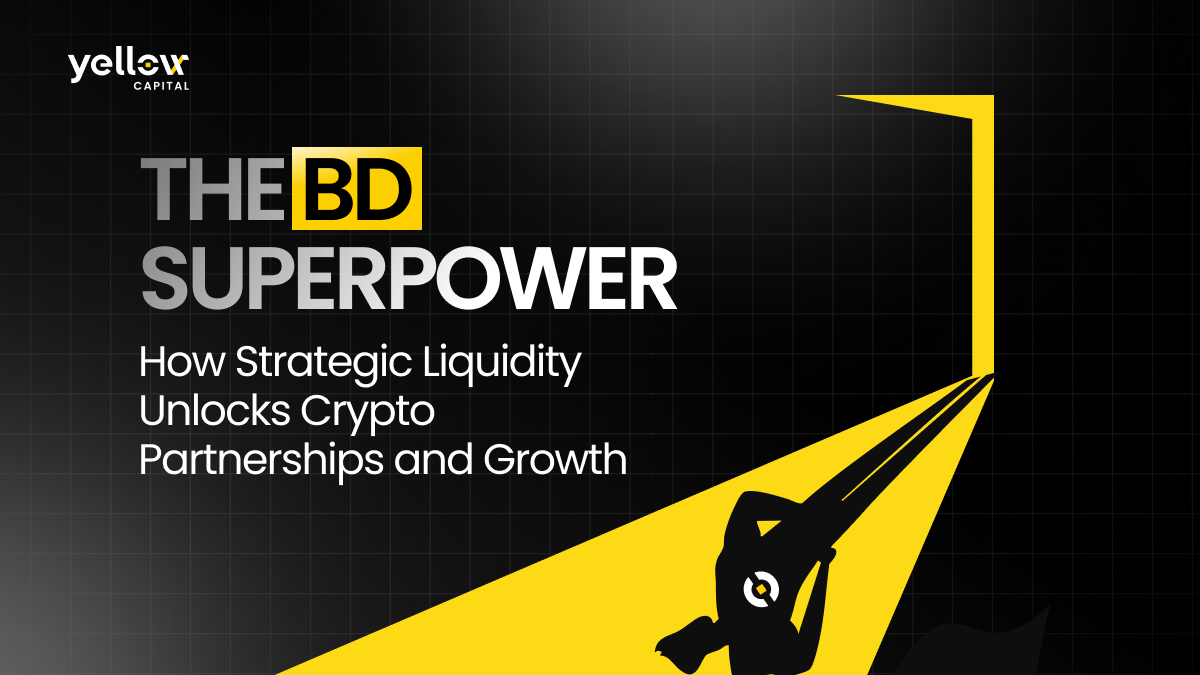- July 25, 2025
- Category: Crypto Liquidity

By Stan Liutenko, VP of Growth at Yellow Capital.
In my seven years in crypto, I’ve sat in hundreds of partnership meetings. I’ve seen brilliant founders with game-changing tech, slick presentations, and a vision that could reshape a whole ecosystem. But I’ve also seen many of those promising conversations fizzle out for a reason that has nothing to do with their slides.
Here’s a scenario every BD person knows. You identify the perfect partner – a top wallet, another protocol, or a major dApp. You get the meeting, you nail the pitch, and their team seems genuinely excited. Then, one of the first things they do, sometimes right there on the call, is open a browser tab to CoinGecko, CoinMarketCap, or a major exchange. They’re not just checking your price. They’re running a silent, instant partnership readiness test. What they see there – the 24-hour volume, the bid-ask spread, the depth of the order book – is often more important than anything you just said.
This article isn’t about trading. It’s for founders and my fellow BD pros. I’m going to break down how a healthy, liquid market is one of the most powerful tools in your growth toolkit – a tool that signals trust, unlocks exchange listings, and enables your entire ecosystem.
Liquidity: Your Project’s Loudest Signal of Trust
From a partner’s perspective, a liquid market is a direct signal of project health, maturity, and legitimacy. Think about it from their side. An illiquid token with a wide spread and high slippage isn’t just a chart – it’s a bright red flag.
It signals risk. It tells them that the project might be immature, lack a strong community, or have low conviction from holders. It makes any potential integration a massive liability for them and, more importantly, for their users. Good liquidity is a non-verbal way of telling potential partners that you are a serious, stable project ready for the main stage.
Real-world example: Imagine a top-tier crypto wallet wants to add your token to their in-app swap feature. They have millions of users. If one of their users tries to swap $5,000 worth of $USDC for your token and the price jumps 8% because of slippage, who gets the angry support ticket? The wallet does. If a user tries to sell and the price crashes 10% on a small order, the wallet’s reputation suffers. You haven’t just pitched a partnership; you’ve pitched them a customer service nightmare. A liquid market removes that risk entirely.
The Real Story Behind Getting on a Tier-1 Exchange
Every founder wants to get their token listed on a major exchange. It’s a huge milestone for growth and visibility. But there’s a common misconception about how it happens. You don’t just show up with a great project and a check.
Exchanges are businesses. They make money from trading fees. Their core business model relies on volume. They have zero incentive to list a token that has no trading activity, because it won’t generate any revenue for them. They won’t dedicate marketing resources or technical support to a token that their users can’t trade efficiently.
This is where a professional market maker is critical. They don’t just “provide liquidity” in a passive sense. They work to build a consistent and provable track record of volume and stability that makes your token attractive to exchanges. This track record is the prerequisite for even starting the listing conversation.
How it works in practice: When you approach an exchange like KuCoin, Bybit, or even Binance, their listings team has a data-driven process. They look at your daily trading volume on existing DEXs or smaller CEXs. If you’re consistently showing $750,000+ in daily volume with a tight 0.1% spread, you represent a real business opportunity for them. You’ve proven that there is a market for your token. If you’re showing $15,000 in volume with a 4% spread and huge gaps in the order book, the conversation is over before it begins.
Fueling Your Ecosystem: Why Integrations Depend on Liquidity
The best partnerships in crypto go beyond simple co-marketing. They involve deep technical integrations where another project uses your token for rewards, governance, payments, or as collateral. These are the partnerships that create real, defensible value. But they are completely dependent on one thing: the ability for your partner to acquire and liquidate your token efficiently.
If the liquidity is poor, the operational friction is just too high for them. It makes your token unusable. Strategic market making removes this barrier, transforming your token from a speculative asset into a viable piece of infrastructure that others can build with.
A practical scenario: Let’s say a GameFi project wants to use your token to reward players for completing quests. To do this, their treasury needs to acquire $100,000 worth of your token every month. If your market is thin, their own buying activity will constantly push the price up against them, dramatically increasing their operational costs. The partnership becomes financially unsustainable. Conversely, if your order book is deep, they can execute these buys with minimal market impact, making the integration smooth and predictable. It just works.
So while we in BD spend our days building relationships, it’s crucial to remember that in crypto, those relationships are built on a foundation of verifiable trust and mutual benefit. A healthy, liquid market, managed professionally, is that foundation. It’s not a cost center you try to minimize; it’s a direct and powerful investment in every partnership you pursue, every exchange you pitch, and the entire future of your ecosystem. Your order book isn’t just for traders – it’s your most convincing pitch deck.
Add a comment
You must be logged in to post a comment.

